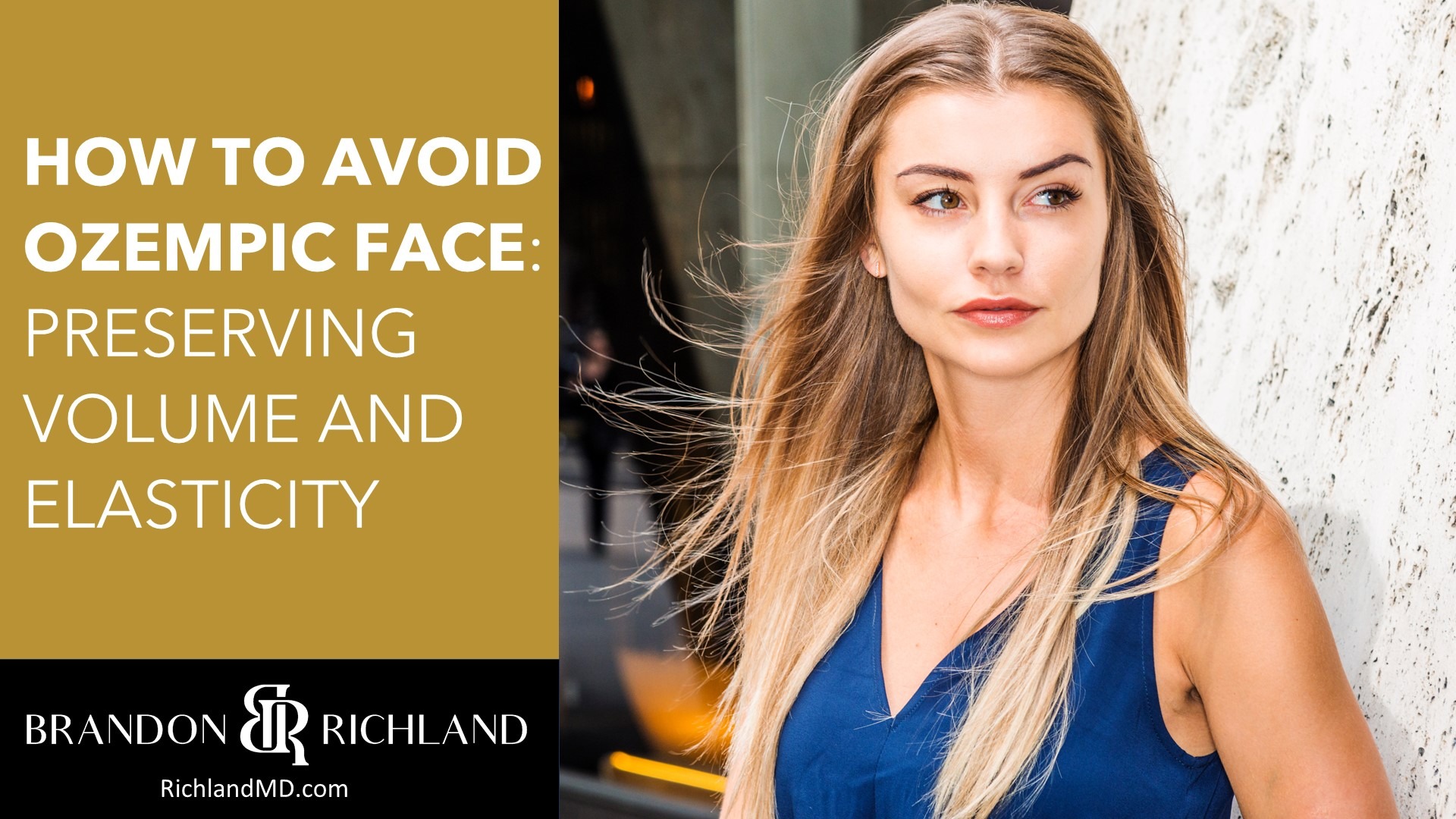Published by Dr. Brandon Richland, MD

Starting a journey with Ozempic for weight loss can be exciting, but it may come with unexpected changes, such as “Ozempic Face.” This Ozempic side effect involves a loss of facial volume and decreased skin elasticity, which can make the skin look aged or tired. To prevent or reduce these effects, maintaining skin elasticity and facial volume is crucial.
Effective strategies include focusing on balanced nutrition to support skin health and incorporating key skincare practices to preserve the youthful look during weight loss. In addition, understanding non-surgical treatments and cosmetic options can provide further support against developing “Ozempic Face.”
Key Takeaways of How to Avoid Ozempic Face
- Preserve facial volume by focusing on skincare and nutrition.
- Consider non-surgical treatments and cosmetic strategies.
- Exercise regularly to aid skin tightening and elasticity.
Understanding Ozempic and Its Effects on the Body Weight
Ozempic is a weight loss medication prescribed primarily to help manage type 2 diabetes. While it is effective for these purposes, some people may experience changes in their facial appearance due to its use. Knowing about these effects can help in making informed decisions.
Overview of Ozempic
Ozempic is a GLP-1 agonist that contains semaglutide as its active ingredient. GLP-1 (glucagon-like peptide-1) medications work by mimicking the incretin hormones, which increase insulin secretion after meals, lower blood sugar levels, and slow gastric emptying. Typically, it is administered as an injection once per week.
Prescribed for type 2 diabetes, Ozempic helps to regulate blood sugar levels and can also promote weight loss by reducing appetite. It is important for individuals to understand its mechanism to better appreciate how it interacts with the body and the effects it may have.
Potential Facial Changes Due to Ozempic
Some users of Ozempic have reported experiencing what is known as “Ozempic face.” This occurs when significant weight loss leads to visible facial changes, such as loss of facial volume. The face may appear more gaunt or saggy as subcutaneous fat diminishes.
Although this is primarily due to rapid or substantial weight loss, not everyone will face these changes. Maintaining a balanced approach to weight loss may help minimize this effect. Being informed about possible facial changes can guide patients in discussing expectations with their healthcare providers.

Preserving Facial Volume During Weight Loss
Maintaining facial volume while losing weight is essential for a youthful look. Focusing on gradual weight loss strategies and bolstering the skin’s collagen and elastin can help minimize undesirable facial changes.
Gradual Weight Loss Strategies
Rapid weight loss can lead to a hollow appearance, often referred to as “Ozempic face.” It’s essential to adopt gradual weight loss strategies that allow the skin time to adjust.
Implementing a healthy, balanced diet and regular exercise routine encourages sustainable weight loss. Slow, consistent weight loss helps preserve facial volume and elasticity. Aim for losing 1-2 pounds per week. This rate supports general health and reduces the risk of loose skin.
Monitoring calorie intake without drastic cuts helps maintain energy levels and supports healthy skin.
Importance of Collagen and Elastin
Collagen and elastin are key proteins that give skin its structure and elasticity. Protecting these during weight loss is crucial for firm, resilient skin.
Consuming foods rich in vitamin C and zinc can naturally enhance collagen production. Incorporating fish, nuts, and leafy greens into the diet supports skin health.
Topical treatments with retinoids may boost collagen, helping to maintain facial volume. In addition, avoiding smoking and reducing sun exposure protects the skin’s ability to produce collagen and elastin.
By focusing on these factors, individuals can help preserve facial volume and maintain a healthy appearance during their weight loss journey.
Optimal Nutrition for Skin Health
Proper nutrition plays a key role in maintaining skin health, particularly by supporting collagen and elastin production, as well as ensuring adequate hydration. Focusing on the right nutrients can help keep skin firm and youthful.
Nutrients That Enhance Collagen and Elastin
Collagen and elastin are essential for skin elasticity. Foods rich in vitamin C, such as oranges and strawberries, aid collagen production. Similarly, zinc found in nuts and seeds contributes to skin repair and growth.
A diet including leafy greens, bell peppers, and tomatoes provides antioxidants that protect skin from damage. Protein is crucial as well; lean meats, beans, and tofu help repair skin tissues. Combining these foods can create a balanced approach to support skin resilience.
Hydration and Healthy Fats in Your Diet
Hydration is vital for skin elasticity. Drinking plenty of water throughout the day helps maintain skin moisture. Herbal teas and water-rich fruits like watermelon also contribute to hydration.
Healthy fats are equally important. Foods like avocados, nuts, and olive oil provide essential fatty acids that nourish and soften skin. These fats help maintain the lipid barrier, which protects against dryness and irritation. Consuming a mix of these elements supports smooth, vibrant skin.
Exercise and Physical Activity for Skin Tightening
Exercise plays a crucial role in maintaining skin elasticity and preventing sagging. Incorporating strength training and facial exercises can help preserve skin firmness and youthfulness.

Strength Training for Muscle Mass Preservation
Strength training helps in maintaining muscle mass, which is vital for preventing sagging skin. When muscle mass decreases, the skin has less support, which can lead to sagging. Engaging in strength exercises such as lifting weights or using resistance bands can improve muscle tone and provide a more defined appearance.
Strength training activities include:
- Weight Lifting: Using free weights or machines
- Resistance Bands: Performing exercises that target major muscle groups
- Bodyweight Exercises: Push-ups, squats, and lunges
Regular strength training not only improves muscle mass but also enhances overall body composition.
Facial Exercises for Skin Elasticity
Facial exercises are simple routines that target specific areas of the face to enhance skin elasticity. These exercises can help reduce the appearance of sagging skin by toning facial muscles. Consistent practice of these exercises can lead to firmer, more youthful-looking skin.
Some effective facial exercises include:
- Cheek Lifters: Smile with lips closed and then lift cheeks
- Jawline Definer: Tilt head back slightly and move the lower jaw
- Forehead Smoothers: Press fingers on the forehead and lift brows
Facial exercises help by stimulating blood flow and keeping the underlying muscles active, which supports the overlying skin.
Advanced Treatment Options and Considerations
For those looking to address significant changes in facial volume and elasticity, surgical procedures and potential side effects are key topics to consider. Procedures like facelifts and neck lifts offer substantial benefits, while understanding possible risks is crucial.
Exploring Surgery: Facelifts and Neck Lifts
Facelifts and neck lifts are surgical options that can help rejuvenate the face by lifting and tightening sagging skin. Facelifts focus on the lower two-thirds of the face, addressing issues like jowls and deep wrinkles. Neck lifts target sagging skin and muscle laxity below the jawline.
Both procedures can provide dramatic results, often restoring a youthful appearance. They involve making incisions, lifting tissues, and sometimes removing or repositioning fat. Fat grafting is often used alongside these surgeries to further enhance facial volume and contour. It’s crucial to consult with experienced surgeons to understand the techniques and expected outcomes.
Frequently Asked Questions about How to Avoid Ozempic Face
1. What Are The Signs Of Changes In Facial Structure Related To Ozempic Use?
Changes in facial structure, often called “Ozempic Face,” can include sagging skin, hollow cheeks, and reduced facial volume. These changes result in an older or more gaunt appearance.
2. How Can One Prevent Sagging Skin While Undergoing Treatment With Ozempic?
Gradual weight loss is key to minimizing sagging skin. Regular facial exercises might help maintain muscle tone. Staying hydrated and keeping skin moisturized are also important.
3. Are There Any Effective Collagen Supplements To Counteract The Effects Of Ozempic On Facial Volume?
Collagen supplements, like powders or capsules, may help improve skin elasticity and hydration. However, their effectiveness can vary, and it’s best to consult a healthcare professional before starting any new supplement.
4. What Methods Are Celebrities Using To Maintain Facial Fullness While Taking Ozempic?
Celebrities may use dermal fillers or other cosmetic procedures to keep a youthful facial appearance. These methods require professional consultation to ensure safety and effectiveness.

Conclusion and Summary of How to Avoid Ozempic Face: Preserving Volume and Elasticity
While weight loss medications like Ozempic provide an effective tool for achieving fat loss, it is important to understand Ozempic face what causes the unexpected changes, such as facial fat loss. Ensuring that you follow a balanced diet, incorporating nutrient-rich foods like lean meats fish eggs, and keeping a good hydration, not only supports overall health but also aids in maintaining a youthful facial appearance.
Moreover, cosmetic options like facial fillers can serve as a viable solution when traditional methods fall short, proving that with the right approach, Ozempic face be reversed while still celebrating the benefits of your weight loss journey.
Please note that this article is intended for informational purposes only and should not be construed as medical advice. Before making any changes to your treatments, please consult with your healthcare provider to discuss the appropriateness and safety of such changes.
Ready For Your First-Class Cosmetic Experience in Orange County (OC) California (CA)?
Are you located in one of these Orange County (OC) / Southern California cities?
Aliso Viejo, Anaheim, Brea, Buena Park, Costa Mesa, Coto de Caza, Cypress, Dana Point, Fountain Valley, Fullerton, Garden Grove, Huntington Beach, Irvine, La Habra, La Palma, Laguna Beach, Laguna Hills, Laguna Niguel, Laguna Woods, Ladera Ranch, Lake Forest, Los Alamitos, Mission Viejo, Newport Beach, Orange, Placentia, Rancho Santa Margarita, San Clemente, San Juan Capistrano, Santa Ana, Seal Beach, Stanton, Tustin, Villa Park, Westminster, or Yorba Linda?
Plastic Surgeon Dr. Brandon Richland, MD and our Cosmetic Aesthetics Team are ready to help you look and feel your absolute best.
Elevate your confidence and self esteem levels to unfathomable new heights!
Schedule your in-person consultation in our modern and luxurious offices in either Fountain Valley, CA (Main HQ) or our Newport Beach, CA office.
Do you live outside of Southern California or short on time? For your convenience, Virtual Consultations are also available.
Our warm and engaging Team of carefully selected Aesthetics Professionals will make you feel calm, cool, collected, and right at home throughout your entire consultation and surgery process.
Schedule Your Aesthetics Consultation here, or call us directly at 949-867-4496 today.
About the Author

Dr. Brandon Richland, MD is a respected Board Certified Licensed Plastic Surgeon in Orange County / Southern California specializing in cosmetic and reconstructive surgeries.
Driven by his passion for medicine, Dr. Richland obtained his Doctor of Medicine (M.D.) degree from the prestigious program at Saint Louis University (SLU) School of Medicine in 2013. His exceptional skills were recognized when he received the McGraw Hill / Lange Medical Student Academic Achievement Award, and graduated top of his class with Honors. For his undergraduate degree, he attended University of California, Los Angeles (UCLA) and graduated with Honors in 2009.
To further enhance his surgical expertise, Dr. Richland completed his Residency in Plastic Surgery at the University of California, Irvine (UCI) from 2013 to 2019 earning the Academic Achievement Award twice during this period. A total of 14 years in dedicated schooling and medical residency.
Dr. Richland is actively involved with healthcare and medical societies, as a Diplomate of the American Board of Plastic Surgery, a member of the American Society of Plastic Surgeons, American Society of Aesthetic Plastic Surgeons, and the California Society of Plastic Surgeons.
Contact Dr. Richland today by visiting RichlandMD.com, scheduling a cosmetic consultation, or by calling 949-867-4496 directly.
Cover Image Credit: Xcai / 123RF.com (Licensed). Photo Illustration by: Dr. Brandon Richland, MD.










